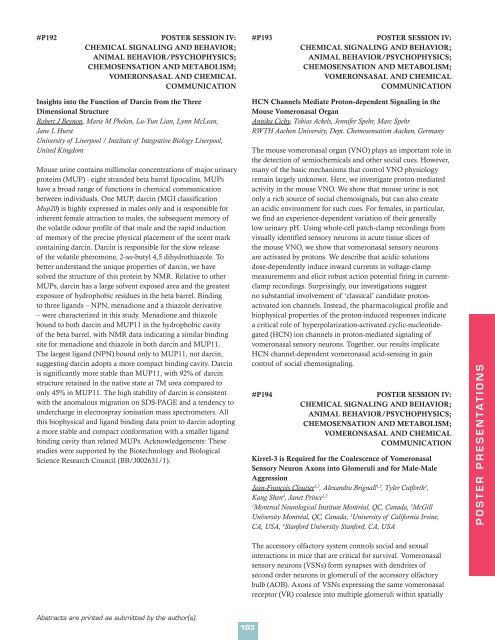Abstracts - Association for Chemoreception Sciences
Abstracts - Association for Chemoreception Sciences
Abstracts - Association for Chemoreception Sciences
You also want an ePaper? Increase the reach of your titles
YUMPU automatically turns print PDFs into web optimized ePapers that Google loves.
#P192 POSTER SESSION IV:<br />
CHEMICAL SIGNALING AND BEHAVIOR;<br />
ANIMAL BEHAVIOR/PSYCHOPHYSICS;<br />
CHEMOSENSATION AND METABOLISM;<br />
VOMERONSASAL AND CHEMICAL<br />
COMMUNICATION<br />
#P193 POSTER SESSION IV:<br />
CHEMICAL SIGNALING AND BEHAVIOR;<br />
ANIMAL BEHAVIOR/PSYCHOPHYSICS;<br />
CHEMOSENSATION AND METABOLISM;<br />
VOMERONSASAL AND CHEMICAL<br />
COMMUNICATION<br />
Insights into the Function of Darcin from the Three<br />
Dimensional Structure<br />
Robert J Beynon, Marie M Phelan, Lu-Yun Lian, Lynn McLean,<br />
Jane L Hurst<br />
University of Liverpool / Institute of Integrative Biology Liverpool,<br />
United Kingdom<br />
Mouse urine contains millimolar concentrations of major urinary<br />
proteins (MUP) - eight stranded beta barrel lipocalins. MUPs<br />
have a broad range of functions in chemical communication<br />
between individuals. One MUP, darcin (MGI classification<br />
Mup20) is highly expressed in males only and is responsible <strong>for</strong><br />
inherent female attraction to males, the subsequent memory of<br />
the volatile odour profile of that male and the rapid induction<br />
of memory of the precise physical placement of the scent mark<br />
containing darcin. Darcin is responsible <strong>for</strong> the slow release<br />
of the volatile pheromone, 2-sec-butyl 4,5 dihydrothiazole. To<br />
better understand the unique properties of darcin, we have<br />
solved the structure of this protein by NMR. Relative to other<br />
MUPs, darcin has a large solvent exposed area and the greatest<br />
exposure of hydrophobic residues in the beta barrel. Binding<br />
to three ligands – NPN, menadione and a thiazole derivative<br />
– were characterized in this study. Menadione and thiazole<br />
bound to both darcin and MUP11 in the hydrophobic cavity<br />
of the beta barrel, with NMR data indicating a similar binding<br />
site <strong>for</strong> menadione and thiazole in both darcin and MUP11.<br />
The largest ligand (NPN) bound only to MUP11, not darcin,<br />
suggesting darcin adopts a more compact binding cavity. Darcin<br />
is significantly more stable than MUP11, with 92% of darcin<br />
structure retained in the native state at 7M urea compared to<br />
only 45% in MUP11. The high stability of darcin is consistent<br />
with the anomalous migration on SDS-PAGE and a tendency to<br />
undercharge in electrospray ionisation mass spectrometers. All<br />
this biophysical and ligand binding data point to darcin adopting<br />
a more stable and compact con<strong>for</strong>mation with a smaller ligand<br />
binding cavity than related MUPs. Acknowledgements: These<br />
studies were supported by the Biotechnology and Biological<br />
Science Research Council (BB/J002631/1).<br />
HCN Channels Mediate Proton-dependent Signaling in the<br />
Mouse Vomeronasal Organ<br />
Annika Cichy, Tobias Ackels, Jennifer Spehr, Marc Spehr<br />
RWTH Aachen University, Dept. Chemosensation Aachen, Germany<br />
The mouse vomeronasal organ (VNO) plays an important role in<br />
the detection of semiochemicals and other social cues. However,<br />
many of the basic mechanisms that control VNO physiology<br />
remain largely unknown. Here, we investigate proton-mediated<br />
activity in the mouse VNO. We show that mouse urine is not<br />
only a rich source of social chemosignals, but can also create<br />
an acidic environment <strong>for</strong> such cues. For females, in particular,<br />
we find an experience-dependent variation of their generally<br />
low urinary pH. Using whole-cell patch-clamp recordings from<br />
visually identified sensory neurons in acute tissue slices of<br />
the mouse VNO, we show that vomeronasal sensory neurons<br />
are activated by protons. We describe that acidic solutions<br />
dose-dependently induce inward currents in voltage-clamp<br />
measurements and elicit robust action potential firing in currentclamp<br />
recordings. Surprisingly, our investigations suggest<br />
no substantial involvement of ‘classical’ candidate protonactivated<br />
ion channels. Instead, the pharmacological profile and<br />
biophysical properties of the proton-induced responses indicate<br />
a critical role of hyperpolarization-activated cyclic-nucleotidegated<br />
(HCN) ion channels in proton-mediated signaling of<br />
vomeronasal sensory neurons. Together, our results implicate<br />
HCN channel-dependent vomeronasal acid-sensing in gain<br />
control of social chemosignaling.<br />
#P194 POSTER SESSION IV:<br />
CHEMICAL SIGNALING AND BEHAVIOR;<br />
ANIMAL BEHAVIOR/PSYCHOPHYSICS;<br />
CHEMOSENSATION AND METABOLISM;<br />
VOMERONSASAL AND CHEMICAL<br />
COMMUNICATION<br />
Kirrel-3 is Required <strong>for</strong> the Coalescence of Vomeronasal<br />
Sensory Neuron Axons into Glomeruli and <strong>for</strong> Male-Male<br />
Aggression<br />
Jean-François Cloutier 1,2 , Alexandra Brignall 1,2 , Tyler Cut<strong>for</strong>th 3 ,<br />
Kang Shen 4 , Janet Prince 1,2<br />
1<br />
Montreal Neurological Institute Montréal, QC, Canada, 2 McGill<br />
University Montréal, QC, Canada, 3 University of Cali<strong>for</strong>nia Irvine,<br />
CA, USA, 4 Stan<strong>for</strong>d University Stan<strong>for</strong>d, CA, USA<br />
POSTER PRESENTATIONS<br />
The accessory olfactory system controls social and sexual<br />
interactions in mice that are critical <strong>for</strong> survival. Vomeronasal<br />
sensory neurons (VSNs) <strong>for</strong>m synapses with dendrites of<br />
second order neurons in glomeruli of the accessory olfactory<br />
bulb (AOB). Axons of VSNs expressing the same vomeronasal<br />
receptor (VR) coalesce into multiple glomeruli within spatially<br />
<strong>Abstracts</strong> are printed as submitted by the author(s).<br />
103
















